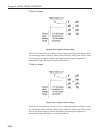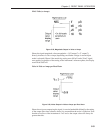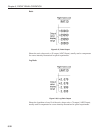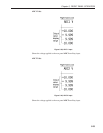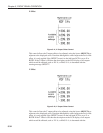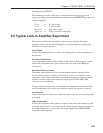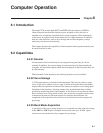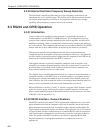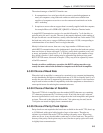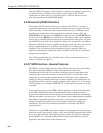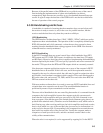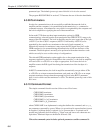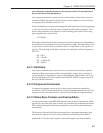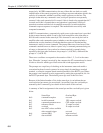
6-2
Chapter 6, COMPUTER OPERATION
6.2.04 Internal Oscillator Frequency Sweep Generator
The instrument’s internal oscillator may be swept in frequency both linearly and
logarithmically over a specified range. This facility allows the instrument to function
as a simple swept-frequency oscillator, or, in conjunction with the curve storage
capability, allows frequency response curves to be recorded.
6.3 RS232 and GPIB Operation
6.3.01 Introduction
Control of the lock-in amplifier from a computer is accomplished by means of
communications over the RS232 or GPIB interfaces. The communication activity
consists of the computer sending commands to the lock-in amplifier, and the lock-in
amplifier responding, either by sending back some data or by changing the setting of
one of its controls. The commands and responses are encoded in standard 7-bit ASCII
format, with one or more additional bits as required by the interface (see below).
The two ports cannot be used simultaneously, but when a command has been
completed, the lock-in amplifier will accept a command at either port. Also when the
test echo facility has been activated all output from the computer to the GPIB can be
monitored by a terminal attached to the RS232 connector.
Although the interface is primarily intended to enable the lock-in amplifier to be
operated by a computer program specially written for an application, it can also be
used in the direct, or terminal, mode. In this mode the user enters commands on a
keyboard and reads the results on a video screen.
The simplest way to establish the terminal mode is to connect a standard terminal, or
a terminal emulator, to the RS232 port. A terminal emulator is a computer running
special-purpose software that makes it act as a terminal. In the default (power-up)
state of the port, the lock-in amplifier sends a convenient prompt character when it is
ready to receive a command, and echoes each character that is received.
Microsoft Windows versions 3.1 and 3.11 include a program called Terminal, usually
in the Accessories group, which may be used as a terminal emulator. On the other
hand, a simple terminal program with minimal facilities can be written in a few lines
of BASIC code (see appendix C.1).
6.3.02 RS232 Interface - General Features
The RS232 interface in the model 7220 is implemented with three wires; one carries
digital transmissions from the computer to the lock-in amplifier, the second carries
digital transmissions from the lock-in amplifier to the computer and the third is the
Logic Ground to which both signals are referred. The logic levels are ±12 V referred
to Logic Ground, and the connection may be a standard RS232 cable in conjunction
with a null modem or alternatively may be made up from low-cost general purpose
cable. The pinout of the RS232 connectors are shown in appendix B and cable
diagrams suitable for coupling the instrument to a computer are shown in
appendix D.



